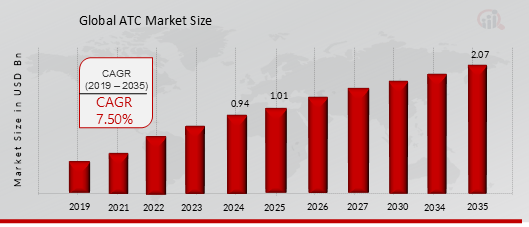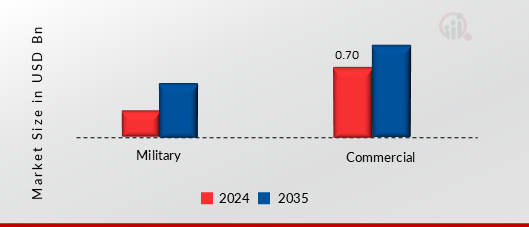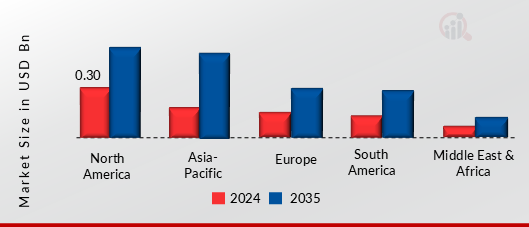Global ATC Market Overview
ATC Market Size Valued at USD 0.94 Billion In 2024. The Global ATC Industry Is Projected to Grow from USD 1.01 Billion In 2025 To USD 2.07 Billion By 2035, Exhibiting A Compound Annual Growth Rate (CAGR) Of 7.50% During the Forecast Period (2025 - 2035).
Rising Air Traffic, Advancement In ATC, And Growing Focus On Air Safety Is Driving the ATC Market.
As per Analyst at MRFR,” The global Air Traffic Control (ATC) market is a dynamic sector that provides various services to ensure the safe and efficient management of air traffic.
These services include airspace management, air traffic flow management, communication, navigation, surveillance systems, and related technologies. The demand for ATC services is closely tied to trends in the aviation industry, with demand increasing during periods of high air travel and decreasing during aviation slowdowns”

Source: Secondary Research, Primary Research, Market Research Future Database, and Analyst Review
ATC Market Trends
USE OF SATELLITE-BASED AIR TRAFFIC CONTROLLER
The adoption of satellite-based air traffic control represents a promising opportunity within the ATC Market. Satellite technology offers a versatile solution to overcome the limitations of ground-based systems, especially in remote and challenging geographic regions. By leveraging satellite networks, ATC coverage can be extended to previously underserved areas, enhancing global air traffic management capabilities. Satellite-based systems enable real-time tracking of aircraft, regardless of their location. This capability improves situational awareness, enhances navigation accuracy, and ensures smoother coordination between aircraft and control centers.
Additionally, satellite technology can facilitate direct communication between aircraft, enhancing communication efficiency and reducing reliance on ground-based infrastructure. Embracing satellite-based ATC requires investments in satellite infrastructure, ground stations, and communication protocols. However, the potential benefits in terms of expanded coverage, improved safety, and enhanced operational efficiency make this opportunity compelling. As satellite technology continues to evolve, the integration of satellite-based air traffic control is poised to redefine the landscape of global aviation.
ATC Market Segment Insights
Global ATC By Component Insights
The ATC Market, in this report, has been segmented on the basis of Component into Hardware, Software, and Services. The Hardware segment dominated the global market in 2024, while the Software is projected to be the fastest–growing segment during the forecast period.
ATC systems are complex and involve various hardware components to ensure the safe and efficient management of air traffic. These components work together to provide communication, surveillance, navigation, and control capabilities. Some of the key hardware components typically found in ATC systems are related toradar systems, communication systems, navigation systems, automation & processing systems, surveillance systems, and backup & redundancy systems. Primary Surveillance Radar (PSR) help in detecting the position and basic information of aircraft using radio waves.
Secondary Surveillance Radar (SSR) provides additional information about aircraft, such as identification, altitude, and mode. Mode S Transponder is a type of transponder that communicates more detailed information to SSR interrogations. VHF Radios, HF Radios are components of communication systems used for voice communication between controllers & pilots. Distance Measuring Equipment (DME) is a navigation system used to measures the slant distance between the aircraft and a ground station. Radar Data Processing System are used to collects, processes, and displays radar data to controllers. Whereas, flight data processing systemshelp in managing flight plans, aircraft data, and coordination between sectors.
Global ATC By Airspace Insights
The ATC Market, in this report, has been segmented on the basis of Airspace into Air Route Traffic Control Centers (ARTCC), Terminal Radar Approach Control (TRACON), Air Traffic Control Tower (ATCT), and Remote Tower (RT). The Air Traffic Control Towers (ATCT) segment dominated the global market in 2024, while the Remote Towers (RT) is projected to be the fastest–growing segment during the forecast period.
Air Route Traffic Control Center (ARTCC) primarily handle en-route air traffic, providing services to aircraft flying at higher altitudes. They manage the airspace between terminal areas and coordinate the safe and efficient flow of traffic through their designated sectors. An ARTCC's airspace is divided into sectors, each with its own team of controllers. These sectors are responsible for managing a specific portion of the ARTCC's coverage area. Controllers in each sector handle a certain number of aircraft and provide services such as route clearances, altitude assignments, and traffic separation.
ARTCCs use primary surveillance radar (PSR) and secondary surveillance radar (SSR) to track aircraft. PSR detects the presence of aircraft based on radar reflections, while SSR provides additional information about the aircraft, such as its identification, altitude, and mode. ARTCCs play a critical role in responding to emergency situations. They provide assistance to distressed aircraft, coordinate search and rescue operations, and facilitate communication between pilots and emergency responders.
Global ATC By Application Insights
The ATC market in this report has been segmented on the basis of Application into two types, namely Communication, Navigation, Surveillance, and Automation. The Communication Systems segment dominated the global market in 2024, while the Automation Systems is projected to be the fastest–growing segment during the forecast period.
Communication is a fundamental aspect of air traffic control (ATC) operations, ensuring the safe and efficient movement of aircraft in the airspace and at airports. Effective communication between air traffic controllers and pilots is essential for providing clear instructions, relaying critical information, and maintaining situational awareness. Voice communication is the primary means of interaction between controllers and pilots. Controllers use VHF (Very High Frequency) radios to communicate with aircraft. Different frequencies are used for different phases of flight, such as ground control, tower control, approach control, and en-route control.
Controllers issue clearances and instructions to pilots via voice communication. These may include taxi instructions, takeoff clearances, landing clearances, altitude assignments, heading changes, and more. In addition to voice communication, data link communication systems allow for text-based messaging between controllers and pilots. Controller-Pilot Data Link Communications (CPDLC) is a form of data link communication used for non-urgent messages and clearances. Effective communication is critical during emergencies. Controllers provide guidance and instructions to pilots facing critical situations, while pilots report emergencies to controllers for prompt assistance
Global ATC By Airport Size Insights
The ATC market in this report has been segmented on the basis of small, medium and large. The Medium segment dominated the global market in 2024, while the Large is projected to be the fastest–growing segment during the forecast period.
Air traffic control (ATC) services for medium-sized airports involve managing a higher volume of air traffic compared to smaller airports while still providing safe and efficient operations. Medium airports typically have a greater mix of commercial, general aviation, and possibly some regional airline traffic. Most medium airports have control towers that provide a range of services, including ground control, tower control, and possibly approach control. They manage runway operations, issue clearances, and ensure safe aircraft movements. Controllers coordinate takeoffs, landings, and ground movements to maintain safe separation and minimize delays.
Approach and departure controllers manage traffic in the terminal airspace, sequencing aircraft for arrivals and ensuring safe departures. They also manage airspace transitions between en-route airspace and terminal airspace.
Medium airports may be in proximity to other airports, requiring close coordination with adjacent ATC facilities to manage traffic flows and prevent conflicts. Controllers at medium airports work with air traffic flow management (ATFM) centers to manage traffic flows and reduce congestion, particularly during peak hours. These airports have established emergency response procedures, and controllers play a critical role in coordinating responses to emergencies and incidents.
Global ATC By Sector Insights
The ATC market in this report has been segmented on the basis of Military & Defense, and Commercial. The Commercial segment dominated the global market in 2024, while the Commercial is projected to be the fastest–growing segment during the forecast period.
Air traffic control (ATC) in the commercial sector focuses on managing the safe and efficient movement of commercial airline flights within controlled airspace and at airports. It involves coordinating the operations of commercial airlines, managing air traffic flow, providing navigation assistance, and ensuring a high level of safety for passengers and crew. Air Traffic Flow Management (ATFM) involves coordinating the flow of air traffic to optimize airspace and runway usage, minimize delays, and ensure efficient operations. ATFM centers collaborate with airlines and ATC facilities to manage traffic flows.
En-route controllers manage commercial flights as they travel between departure and arrival airports.
They provide altitude assignments, route clearances, and ensure safe separation between aircraft. ATC for commercial airlines often involves international flights, requiring coordination with ATC facilities in different countries and adherence to international regulations. Commercial ATC systems are designed with redundancy to ensure operational continuity even in the event of equipment failures. ATC in the commercial sector is essential for the safe and orderly movement of flights, supporting the global aviation industry and ensuring passengers reach their destinations safely and on time.
Figure 1: ATC Market, By Sector, 2024 & 2035 (USD BILLION)

Global ATC Regional Insights
The report on the ATC Market has been segmented on the basis of region as: North America, Europe, Asia Pacific, Middle East & Africa, and South America. North America accounted for the largest market share in 2024 and is anticipated to reach USD 0.94 Billion by 2035 and projected to grow at the highest CAGR of 7.50% during the forecast period.
The North American ATC market is one of the largest and most sophisticated in the world, given the high volume of air traffic in the region. It is a hub for commercial aviation, with numerous major airlines & airports. The region experiences consistent growth in passenger and cargo traffic, necessitating effective ATC services to manage the increased volume of flights. Air travel demand in North America is increasing due to a combination of economic, demographic, technological, and cultural factors. The interconnected global economy necessitates international travel for business, trade, and investment.
It’s role as a global economic center contributes to the demand for international flights. The region hosts numerous multinational corporations, conventions, and trade shows, leading to frequent business travel between cities and countries.
North America is also a popular destination for international tourists, including attractions like cultural sites, entertainment centers, natural landscapes, and major events. The influx of tourists is driving the demand for air travel. Major events such as sports tournaments, conferences, festivals, and entertainment spectacles are attracting visitors from around the world, resulting in spikes in air travel demand in the region. Strong economic growth in North America is leading to increased business & leisure travel, further driving the demand for ATC services to accommodate additional flights. Many international flights cross North American airspace, necessitating coordination with neighboring countries’ ATC systems.
The growth of global air travel is thus contributing to increased demand for ATC services in the region.
Figure 2: ATC Market, By Region, 2024 & 2035 (USD BILLION)

Further, the major countries studied in the market report are the U.S., Canada, Mexico, Germany, , Germany, U.K., France, Italy, Spain, Russia, Rest of Europe, China, Japan, India, Australia, Indonesia, South Korea, Rest of Asia Pacific , GCC , South Africa, Rest of Middle East & Africa , Brazil , Chile, Rest of South America .
Global ATC Key Market Players & Competitive Insight
Many global, regional, and local vendors characterize the ATC Market. The market is highly competitive, with all the players competing to gain market share. Intense competition, rapid advances in technology, frequent changes in government policies, and environmental regulations are key factors that confront market growth. The vendors compete based on cost, product quality, reliability, and government regulations. Vendors must provide cost-efficient, high-quality products to survive and succeed in an intensely competitive market.
The major players in the market include Honeywell International Inc, ADACEL Technologies Limited, Bae Systems, FREQUENTIS, Indra Sistemas Sa, Leidos, Leidos, Northrop Grumman Corporation, Raytheon Technologies, Saab Ab, Thales Group, INTELCAN TECHNOSYSTEMS Inc., SAIPHER ATC, SKYSOFT-ATM, L3HARRIS TECHNOLOGIES, INC., And Among Others. The ATC Market is a consolidated market due to increasing competition, acquisitions, mergers and other strategic market developments and decisions to improve operational effectiveness.
Key Companies in the ATC Market include.
- Honeywell International Inc
- ADACEL Technologies Limited
- Bae Systems
- FREQUENTIS
- Indra Sistemas Sa
- Leidos
- Northrop Grumman Corporation
- Raytheon Technologies
- Saab Ab
- Thales Group
- INTELCAN TECHNOSYSTEMS Inc.
- SAIPHER ATC
- SKYSOFT-ATM
- L3HARRIS TECHNOLOGIES, INC.
ATC Market Industry Developments
-
Q1 2025: Seagate acquisition of Intevac Seagate Technology completed its $95.87 million acquisition of Intevac, Inc., a supplier of thin-film processing systems, on March 31, 2025. Intevac is now a wholly owned subsidiary of Seagate, and its shares have been delisted from the Nasdaq Global Select Market.
-
Q1 2025: AMD acquisition of ZT Systems Advanced Micro Devices (AMD) finalized its $4.9 billion acquisition of ZT Systems, a provider of AI and general-purpose compute infrastructure, on March 31, 2025. The deal was structured as a cash and stock transaction.
-
Q4 2024: CDW (NASDAQ: CDW) acquired AWS cloud solutions provider Mission Cloud Services CDW acquired Mission Cloud Services, an AWS cloud solutions provider, in Q4 2024 as part of its strategy to expand its cloud services portfolio.
-
Q4 2024: Comcast Business (NASDAQ: CMCSA) acquired network managed services provider Nitel Comcast Business acquired Nitel, a network managed services provider, in Q4 2024 to strengthen its managed services offerings.
-
Q4 2024: EY (Ernst and Young) acquired digital identity and access management solutions provider Dignari EY acquired Dignari, a provider of digital identity and access management solutions, in Q4 2024 to enhance its cybersecurity and digital transformation capabilities.
-
Q4 2024: Bell Canada’s FX Innovation acquired ServiceNow Elite solutions provider HGC Technologies FX Innovation, a Bell Canada company, acquired HGC Technologies, a ServiceNow Elite solutions provider, in Q4 2024 to expand its ServiceNow service offerings.
-
Q4 2024: World Wide Technology acquired Softchoice (TSX: SFTC) for approximately C$1.8 billion World Wide Technology acquired Softchoice, a leading IT solutions provider, for approximately C$1.8 billion in Q4 2024, expanding its global technology services footprint.
-
Q4 2024: Xerox (NASDAQ: XRX) acquired IT Savvy for approximately $400 million Xerox acquired IT Savvy, an IT solutions provider, for approximately $400 million in Q4 2024 to strengthen its IT services business.
-
Q3 2024: Amphenol Corporation acquires CommScope (OWN Business) for $2.1 billion Amphenol Corporation acquired the OWN Business unit of CommScope for $2.1 billion in July 2024, expanding its connectivity solutions portfolio.
-
Q3 2024: KBR acquires LinQuest Corporation for $737 million KBR acquired LinQuest Corporation, a provider of space systems technology and services, for $737 million in July 2024.
-
Q1 2024: Amphenol Corporation acquires Carlisle Interconnect Technologies for $2 billion Amphenol Corporation acquired Carlisle Interconnect Technologies for $2 billion in February 2024, strengthening its position in the interconnect solutions market.
-
Q1 2024: Dutch NXP B.V. to Acquire TTTech Auto AG NXP B.V. announced the acquisition of TTTech Auto AG, an Austrian automotive technology company, for $625 million in cash. The deal is aimed at advancing NXP’s software-defined vehicle strategy and is subject to regulatory approval.
ATC Market Segmentation
ATC Market By Component Outlook (USD BILLION, 2019-2035)
- Hardware
- Software
- Services
ATC Market By Airspace Outlook (USD BILLION, 2019-2035)
- Air Route Traffic Control Centers (ARTCC)
- Terminal Radar Approach Control (TRACON)
- Air Traffic Control Tower (ATCT)
- Remote Tower (RT)
ATC Market By Application Outlook (USD BILLION, 2019-2035)
- Communication
- Navigation
- Surveillance
- Automation
ATC Market By Airport Size Outlook (USD BILLION, 2019-2035)
Global ATC Regional Outlook
-
North America
-
Europe
- Germany
- France
- Russia
- Italy
- Spain
- Rest of Europe
-
Asia-Pacific
- China
- India
- Japan
- South Korea
- Malaysia
- Thailand
- Indonesia
- Rest of Asia-Pacific
-
South America
- Brazil
- Argentina
- Rest of South America
-
Middle East
- GCC Countries
- South Africa
- Rest of MEA
|
Report Attribute/Metric
|
Details
|
|
Market Size 2024
|
USD 0.94 BILLION
|
|
Market Size 2025
|
USD 1.01 BILLION
|
|
Market Size 2035
|
USD 2.07 BILLION
|
|
Compound Annual Growth Rate (CAGR)
|
7.50% (2025-2035)
|
|
Base Year
|
2024
|
|
Market Forecast Period
|
2025-2035
|
|
Historical Data
|
2019- 2023
|
|
Market Forecast Units
|
Value (USD BILLION)
|
|
Report Coverage
|
Revenue Forecast, Market Competitive Landscape, Growth Factors, and Trends
|
|
Segments Covered
|
By Component, By Airspace, By Application, By Airport Size, By Sector
|
|
Geographies Covered
|
North America, Europe, Asia-Pacific, South America, Middle East & Africa.
|
|
Countries Covered
|
the U.S., Canada, Mexico, Germany, U.K., France, Italy, Spain, Russia, Rest of Europe, China, Japan, India, Australia, Indonesia, South Korea, Rest of Asia Pacific , GCC , South Africa, Rest of Middle East & Africa , Brazil , Chile, Rest of South America.
|
|
Key Companies Profiled
|
Honeywell International Inc, ADACEL Technologies Limited, Bae Systems, FREQUENTIS, Indra Sistemas Sa, Leidos, Leidos, Northrop Grumman Corporation, Raytheon Technologies, Saab Ab, Thales Group, INTELCAN TECHNOSYSTEMS Inc., SAIPHER ATC, SKYSOFT-ATM, L3HARRIS TECHNOLOGIES, INC., And Among Others
|
|
Key Market Opportunities
|
· Rising Demand for Sustainable and Eco-Friendly Packaging
|
|
Key Market Dynamics
|
· Rising Demand for Packaged Beverages
· Advancements in Packaging Technologies
|
Frequently Asked Questions (FAQ):
The ATC Market size is expected to be valued at USD 2.07 BILLION in 2035.
The global market is projected to grow at a CAGR of 7.50% during the forecast period, 2025-2035.
Asia-Pacific had the largest share of the global market.
The key players in the market are Astec Industries Honeywell International Inc, ADACEL Technologies Limited, Bae Systems, FREQUENTIS, Indra Sistemas Sa, Leidos, Leidos, Northrop Grumman Corporation, Raytheon Technologies, Saab Ab, Thales Group, INTELCAN TECHNOSYSTEMS Inc., SAIPHER ATC, SKYSOFT-ATM, L3HARRIS TECHNOLOGIES, INC., And Among Others.
Air Traffic Control Towers (ATCT) Systems ATC dominated the market in 2024.
The Communication Systems Segment had the largest revenue share of the global market.

















